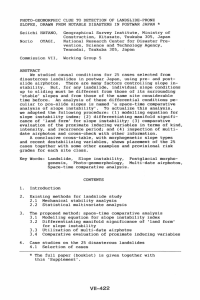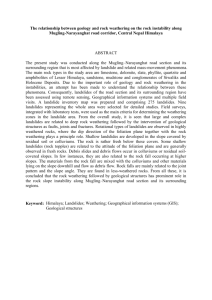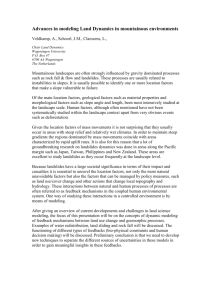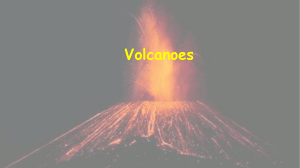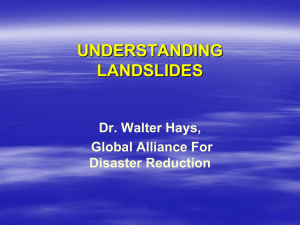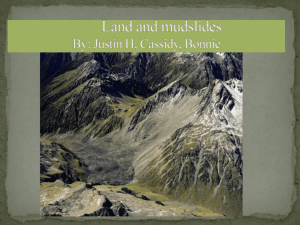AUTOMATIC DETECTION OF LANDSLIDE FEATURES WITH REMOTE SENSING
advertisement
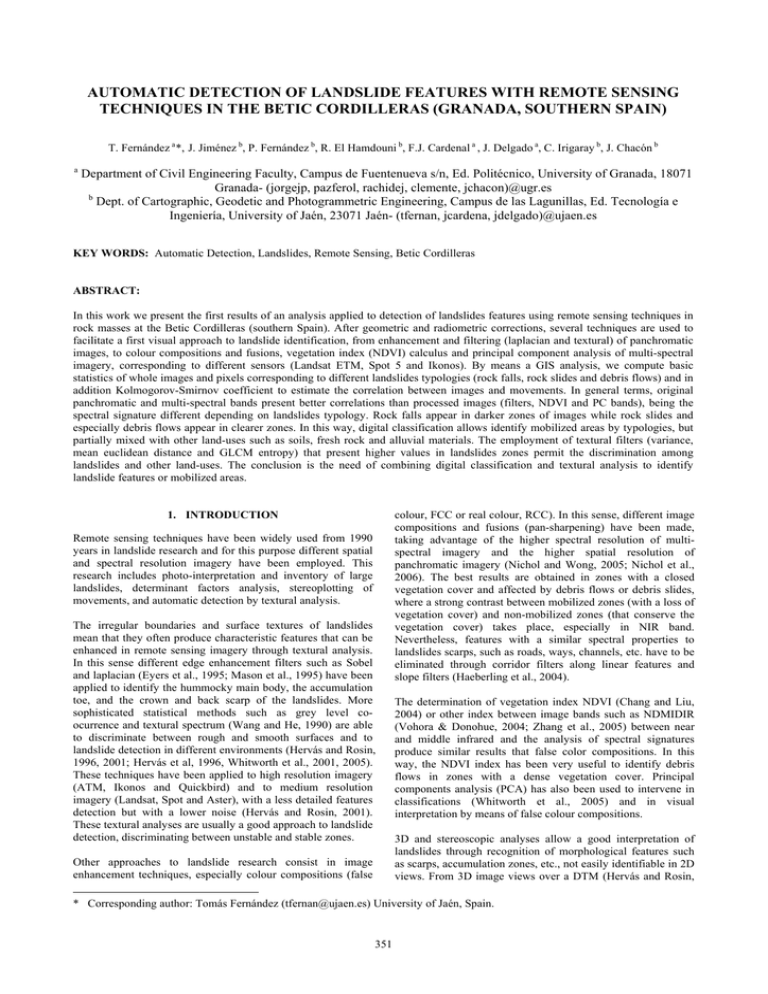
AUTOMATIC DETECTION OF LANDSLIDE FEATURES WITH REMOTE SENSING TECHNIQUES IN THE BETIC CORDILLERAS (GRANADA, SOUTHERN SPAIN) T. Fernández a *, J. Jiménez b, P. Fernández b, R. El Hamdouni b, F.J. Cardenal a , J. Delgado a, C. Irigaray b, J. Chacón b a Department of Civil Engineering Faculty, Campus de Fuentenueva s/n, Ed. Politécnico, University of Granada, 18071 Granada- (jorgejp, pazferol, rachidej, clemente, jchacon)@ugr.es b Dept. of Cartographic, Geodetic and Photogrammetric Engineering, Campus de las Lagunillas, Ed. Tecnología e Ingeniería, University of Jaén, 23071 Jaén- (tfernan, jcardena, jdelgado)@ujaen.es KEY WORDS: Automatic Detection, Landslides, Remote Sensing, Betic Cordilleras ABSTRACT: In this work we present the first results of an analysis applied to detection of landslides features using remote sensing techniques in rock masses at the Betic Cordilleras (southern Spain). After geometric and radiometric corrections, several techniques are used to facilitate a first visual approach to landslide identification, from enhancement and filtering (laplacian and textural) of panchromatic images, to colour compositions and fusions, vegetation index (NDVI) calculus and principal component analysis of multi-spectral imagery, corresponding to different sensors (Landsat ETM, Spot 5 and Ikonos). By means a GIS analysis, we compute basic statistics of whole images and pixels corresponding to different landslides typologies (rock falls, rock slides and debris flows) and in addition Kolmogorov-Smirnov coefficient to estimate the correlation between images and movements. In general terms, original panchromatic and multi-spectral bands present better correlations than processed images (filters, NDVI and PC bands), being the spectral signature different depending on landslides typology. Rock falls appear in darker zones of images while rock slides and especially debris flows appear in clearer zones. In this way, digital classification allows identify mobilized areas by typologies, but partially mixed with other land-uses such as soils, fresh rock and alluvial materials. The employment of textural filters (variance, mean euclidean distance and GLCM entropy) that present higher values in landslides zones permit the discrimination among landslides and other land-uses. The conclusion is the need of combining digital classification and textural analysis to identify landslide features or mobilized areas. 1. INTRODUCTION Remote sensing techniques have been widely used from 1990 years in landslide research and for this purpose different spatial and spectral resolution imagery have been employed. This research includes photo-interpretation and inventory of large landslides, determinant factors analysis, stereoplotting of movements, and automatic detection by textural analysis. The irregular boundaries and surface textures of landslides mean that they often produce characteristic features that can be enhanced in remote sensing imagery through textural analysis. In this sense different edge enhancement filters such as Sobel and laplacian (Eyers et al., 1995; Mason et al., 1995) have been applied to identify the hummocky main body, the accumulation toe, and the crown and back scarp of the landslides. More sophisticated statistical methods such as grey level coocurrence and textural spectrum (Wang and He, 1990) are able to discriminate between rough and smooth surfaces and to landslide detection in different environments (Hervás and Rosin, 1996, 2001; Hervás et al, 1996, Whitworth et al., 2001, 2005). These techniques have been applied to high resolution imagery (ATM, Ikonos and Quickbird) and to medium resolution imagery (Landsat, Spot and Aster), with a less detailed features detection but with a lower noise (Hervás and Rosin, 2001). These textural analyses are usually a good approach to landslide detection, discriminating between unstable and stable zones. Other approaches to landslide research consist in image enhancement techniques, especially colour compositions (false colour, FCC or real colour, RCC). In this sense, different image compositions and fusions (pan-sharpening) have been made, taking advantage of the higher spectral resolution of multispectral imagery and the higher spatial resolution of panchromatic imagery (Nichol and Wong, 2005; Nichol et al., 2006). The best results are obtained in zones with a closed vegetation cover and affected by debris flows or debris slides, where a strong contrast between mobilized zones (with a loss of vegetation cover) and non-mobilized zones (that conserve the vegetation cover) takes place, especially in NIR band. Nevertheless, features with a similar spectral properties to landslides scarps, such as roads, ways, channels, etc. have to be eliminated through corridor filters along linear features and slope filters (Haeberling et al., 2004). The determination of vegetation index NDVI (Chang and Liu, 2004) or other index between image bands such as NDMIDIR (Vohora & Donohue, 2004; Zhang et al., 2005) between near and middle infrared and the analysis of spectral signatures produce similar results that false color compositions. In this way, the NDVI index has been very useful to identify debris flows in zones with a dense vegetation cover. Principal components analysis (PCA) has also been used to intervene in classifications (Whitworth et al., 2005) and in visual interpretation by means of false colour compositions. 3D and stereoscopic analyses allow a good interpretation of landslides through recognition of morphological features such as scarps, accumulation zones, etc., not easily identifiable in 2D views. From 3D image views over a DTM (Hervás and Rosin, * Corresponding author: Tomás Fernández (tfernan@ujaen.es) University of Jaén, Spain. 351 The International Archives of the Photogrammetry, Remote Sensing and Spatial Information Sciences. Vol. XXXVII. Part B8. Beijing 2008 2001; Haeberling et al., 2004) to photogrammetric techniques such as stereoscopic viewing or DTM extraction (Zhihua, 2005; Weirich and Blesius, 2006), these methodologies have been used in landslides studies when data are available. Finally, multi-temporal imagery has been used to study landslide activity from pixel change detection techniques (Rosin and Hervás, 2003) to quantitative 3D analysis of landslides displacement. 2.3 Image data High to medium resolution remote sensing imagery from different satellites in panchromatic and multi-spectral modes have been used. Images properties are summarized in table 1. Spot 5 and Landsat ETM+ images cover the whole zone while Ikonos is available only in the central sector. In Figure 1 we also show the distribution of satellite images. Satellite/ Sensor 2. STUDY AREA AND IMAGE DATA Bands Panchromatic Vis(RGB)-NIR Panchromatic Spot 5 Vis(GB)-NIR SWIR Panchromatic Landsat 7 Vis(RGB)-NIRETM + SWIR TIR Ikonos This is an area prone to terrain instability, because of a combination of an abrupt relief and a geological setting with a high susceptibility to landslides. Resolution Spa Band Rad. 1 1 2048 4 4 2048 2,5 1 256 10 3 256 20 1 256 15 1 256 30 6 256 60 1 256 Table 1. Images properties. Vis: Visible; R: Red; G: Green; B: Blue; NIR: Near Infrared; SWIR: Short-wave (middle) Infrared; TIR: Thermal Infrared 3. IMAGE PROCESSING Image processing employed in this work includes several techniques, from image pre-processing to digital classification that can be seen in figure 2. 3.1 Figure 1. Geographic location. 2.1 Here, we talk about techniques to converting original images to cartographic products and to preparing image to other analysis. First, images have been geometrically corrected and georeferenced in the UTM projection. Correction has been made by means control points and models implemented in ERDAS software for different sensors (Ikonos, Spot, etc.), over a DTM of 10 m resolution. Second, we have applied single Chavez radiometric correction to eliminate atmospheric effects. Geographical location and relief description The study area is located in a region of about 600 Km2, located in Granada province (Southern Spain) at the South of Sierra Nevada, between this range and the coast of Mediterranean Sea. This is a rural area with small villages disseminated overall the region and communicated by secondary roads. The relief is abrupt with a vertical interval near 3000 meters with steep slopes. Drainage network is very dense and organized, with a lot of ravines tributaries of Guadalfeo River. 2.2 Pre-processing 3.2 Enhancement and colour compositions After pre-processing, image bands are enhanced by means of lineal stretch of histograms (figure 2 c), except in Ikonos images where square-root and logarithmic stretch are also applied. The available Ikonos images have wide shaded zones and in this case this non-lineal stretch are recommended (Roberts, 2005). Geology, climate and vegetation From the geological point of view, the area is located within Internal Zones of Betic Cordilleras, between Alpujárride and Nevado-Filabride Domains. Alpujárride Domain is formed by metapelitic and carbonate rock masses, while Nevado-Filabride Domain is formed mainly by metapelitic rock masses. In between them, Neogene and Quaternary materials (conglomerate, sands clays and marls) outcrop. Different colour compositions have been made from corrected image bands. Apart from RCC, FCC with inclusion of NIR band allow to distinguish between zones covered or noncovered by vegetation, a factor which can show the presence of landslide scarps. Other colour compositions with inclusion of SWIR are useful to show lithological changes or boundaries, frequently related to landslides. The climate is typically Mediterranean except in higher zones over 1800 meters. Mean temperatures vary from 12ºC in winter to 18ºC in summer. Annual mean precipitation is about 600-800 mm, but in an irregular regime with wet years over 1000 mm and dry years below 500 mm. Vegetation is variable with zones well vegetated (pine and oak forests, dense brush, grass) and arid zones with scarce vegetation (brush and waste lands). Finally, in those image compositions where Visible and NIR bands intervene, fusion of multi-spectral and panchromatic (that cover VNIR spectrum region) images have been made. These fusion or pan-sharpening techniques provide both RCC and FCC with the higher spatial resolution of panchromatic images (Nichol and Wang, 2005). 352 The International Archives of the Photogrammetry, Remote Sensing and Spatial Information Sciences. Vol. XXXVII. Part B8. Beijing 2008 Figure 2. Spot 5 Image: A. Location; C: Panchromatic corrected image; E: NDVI vegetation index; G: Supervised classification. Figure 2. B. Rock slides location; D: Variance texture filter; F: PC band 1; H: Modified supervised classification. 353 The International Archives of the Photogrammetry, Remote Sensing and Spatial Information Sciences. Vol. XXXVII. Part B8. Beijing 2008 3.3 Filters Sensor Image Band Me St Ikonos 25 13 Pan Laplacian 41 24 Variance 117 26 Mean Eu. 35 12 GLCM E. 139 60 M-Blue 10 6 M-Green 17 10 M-Red 17 11 M-NIR 35 19 NDVI 171 22 PC-1 30 15 PC-2 178 11 PC-3 155 5 PC-4 119 4 Classific. Final im. Spot 5 Pan 31 10 Laplacian 40 23 Variance 135 47 Mean Euc. 57 24 GLCM E. 142 60 M-Green 29 8 M-Red 35 11 M-NIR 50 11 M-SWIR 42 9 NDVI 118 32 PC-1 76 17 PC-2 21 9 PC-3 0 1 PC-4 5 1 Classific. Final im. LSat-Pan 56 12 Laplacian 42 24 Variance 141 28 Mean Euc. 75 43 GLCM E. 186 57 M-Blue 50 12 M-Green 54 14 M-Red 69 23 M-NIR 66 13 M-SW1 101 25 M-SW2 70 20 NDVI 101 31 PC-1 166 39 PC-2 18 12 PC-3 0 0 PC-4 22 5 Classific. Final im. - Different filters have been applied mainly to panchromatic images. First, we use convolution edge-enhancement filters (3x3) such as laplacian and Sobel to find landslides lineal features: scarps, crown, limits, etc. Second, we apply textural filters such as variance (figure 2 d), mean euclidean distance (MEUC) and grey-level co-ocurrence matrix (GCLM) entropy to calculate the variability of one pixel to its neighbourhoods. Nevertheless, these textural filters, especially when they are applied to thermal bands allow detect irregular morphologies as those in landslides (Whitworth et al., 2003, 2005). 3.4 Indexes and transformations Vegetation indexes are very useful to identify landslide and debris flow scarps, especially in zones with a dense vegetation cover (Chang an Liu, 2004). Besides, they decrease the differences between shaded and sunned areas, as those we can find in Ikonos images of the study zone (figure 2 e). PCA allow transform original (corrected) image bands in new uncorrelated bands. By this reason, single bands and FCC elaborated from PCA show a higher variability than original bands and allow detect features more clearly. In this study, we have obtained a number of PC bands equal to original bands. In figure 2 f, PC 1 band is shown. 3.5 Digital classification Digital supervised classification has been made from multispectral imagery (figure 2 g-h), discriminating between four basic land-uses and materials: urbanised-waste lands, vegetation (from grass to cultivations to forest), soils-brush cover, and fresh rock masses-alluvial deposits. Apart of these, landslides in their different typologies have been established as fifth class. In this way, three classified images for each sensor have been elaborated. An analysis of separability of spectral signatures will be done to decide if it is possible to distinguish between landslide typologies and between landslides and stable terrain. 4. GIS ANALYSIS Two approaches have been made: first, visual interpretation from enhanced images, filters, colour compositions and classifications (figure 2); second, a GIS statistical analysis. 4.1 Zone statistical analysis In this analysis, a frequency distribution or histogram of an image in the zone defined by other image o vector feature is obtained. In our case, we determine the histogram of the different image bands in a pixel sample of different typologies of landslides (rock falls, rockslides and debris flows) and compare this with the histogram of whole image. 4.2 Rock falls Slides Me St KS Me St K 18 13 -28 26 14 04 Debris flows Me St KS 23 15 -14 42 106 31 128 8 13 13 24 166 21 176 154 120 27 40 131 53 132 27 30 42 37 115 67 17 0 5 51 42 149 87 201 48 50 62 58 92 66 100 153 15 0 23 - 41 115 35 146 11 18 18 32 164 29 175 154 119 30 40 139 60 153 30 34 47 41 112 74 19 0 5 55 42 152 91 205 50 54 68 63 97 68 100 161 15 0 23 - 23 34 14 58 5 10 12 18 22 16 8 5 3 8 21 47 24 61 7 9 11 8 24 16 7 1 1 12 23 30 48 47 9 13 21 11 27 22 21 43 9 0 3 - 03 -21 -18 -17 -24 -27 -28 -27 -12 -27 -18 -18 12 22 25 -20 02 -07 -06 -07 -13 -19 -26 -23 -10 -22 -19 -04 22 38 42 -21 02 13 13 11 -09 -14 -17 -25 -17 -14 10 -18 -12 0 14 15 16 41 120 37 145 12 19 19 37 168 32 177 154 119 32 40 139 60 151 31 35 48 42 112 77 19 0 5 58 43 148 84 199 51 56 70 67 101 69 99 167 16 0 24 - 25 27 12 56 7 12 13 20 21 17 12 5 4 9 26 47 23 58 8 10 12 8 30 15 10 1 1 12 25 26 46 50 10 12 20 16 23 18 30 36 12 0 5 - 02 07 06 06 07 06 05 04 -05 05 -08 -13 04 19 25 08 02 07 06 06 11 07 -10 04 -11 05 -19 -02 23 25 31 05 03 11 10 10 11 07 05 10 -03 -03 -04 04 -09 0 12 8 10 24 33 14 56 8 13 14 21 23 19 11 5 4 9 25 47 23 56 8 10 11 9 26 17 8 1 1 13 25 30 51 48 11 14 23 15 27 21 28 43 11 0 4 - 02 -10 -08 07 10 -10 -11 -13 -14 -12 -17 -11 03 13 18 -04 02 08 07 07 04 -03 -11 -8 -08 -05 -15 -02 17 26 34 -09 02 17 15 16 02 -02 -04 -11 -08 -05 -03 -06 -11 0 09 7 11 Table 2. Statistical analysis: Me: Mean; St: Standard deviation; KS: Kolmogorov-Smirnov coefficient (normalized to 100). 5. RESULTS Correlation coefficients From the statistics of table 2 and visual interpretation of enhanced images and colour compositions, we can conclude that, in absolute terms, values of KS coefficient are low in all the cases although, in relative terms, some remarks can be outlined. First, rock falls are the typology that shows higher radiometric differences regarding to the whole image, generally with lower DN values in rock falls scarps (darker) than the whole image. These differences can be observed in panchromatic and multi- To determine if an image can be useful to discriminate between landslides and stable zones Kolmogorov-Smirnov coefficient (KS) is calculated. This coefficient shows the differences between whole image histogram and landslide samples histograms. KS coefficient is higher as the difference between histograms or distributions. Results are shown in table 2. 354 The International Archives of the Photogrammetry, Remote Sensing and Spatial Information Sciences. Vol. XXXVII. Part B8. Beijing 2008 Laplacian filter, as an edge-enhancement filter, highlights linear elements and borders, and can be used for delimitate movements, but DN values do not show significative differences regarding original image. Use of textural filters results more interesting in this case, because they produce higher differences between zones of movements and the whole image. In this case the image resolution and observation conditions become very important. In Landsat images, filters present higher DN values in mobilized zones, no matter the typology; in Ikonos slides present also higher values but rock falls and debris flows present lower values than the whole image; and finally, in Spot images DN values of mobilized zones are similar than the whole image. spectral images, as in derivatives (filters, NDVI and PC bands), although differences are higher in original corrected and enhanced images. Filters and NDVI present DN values lower (darker) in rock falls sample than the whole image and a more irregular behaviour of PC images. By sensors, the best results can be observed in Ikonos, while in this case, Spot 5 y Landsat 7 show similar results. Rock slides have very poor correlations (near to 0) in most of cases. Usually, DN values of rock slides sample are relatively higher (clearer) than the whole image in panchromatic image, its filters, the visible bands and some PC bands. However, NIR band, NDVI and some PC bands show lower values than the whole image. Regarding supervised classifications, in figure 3 we show the spectral signatures corresponding to the three classifications determined here. Difficulties to distinguish between landslides and some land-uses can be observed. Rock falls appear very similar to soils, rock slides is only a little darker than soils, and debris flows are very close to fresh rock and alluvial materials. Debris flows present the more irregular results. Regarding to panchromatic image, values are clearly lower than the whole image in Ikonos, but it become similar in images corresponding to Spot 5. On his hand, filters corresponding to Landsat image present higher values in debris flows zones than in the whole image. Regarding to multi-spectral image, most of bands present DN values lower in landslides sample, but in some visible bands can become higher. However, NIR band and NDVI always appear in debris flows with lower DN values than whole image. Finally, in all the movements, KS coefficients calculated in classified images are higher that those obtained in original and derivative bands. 6. DISCUSSION In spite of low Kolmogorov-Smirnov coefficient, the results of GIS analysis allow extract the following observations, regarding enhanced original, filtering and classification images. Starting by original images, rock falls are strongly related to shaded zones in the study area, and because of it, they present lower DN values than the whole image. The higher correlations are found in Ikonos image, taken in winter and with a higher extension of shaded zones, associated frequently with rock falls. This is a local fact, because in this area rock falls are located in the northern slopes of Sierra de Lújar. In other zones, with rock falls in cliffs oriented to South (in northern hemisphere, of course), rock falls can be associated with relative higher DN values, as the other landslides do. To discriminate between the different landslide typology and other land-uses we can use textural filters, specifically variance that shows the best correlations with landslides. In this way, zones of rock slides present higher values of variance than soils do, and debris flows present values of variance clearly higher than fresh rock and alluvial materials do. In both cases, a single matrix approach between classifications and variance filter permits to modify the classification to obtain a final image in which these landslides typologies appear more clearly separate from other land-uses. Zones previously classified (wrongly) as landslides pass to soil or fresh rock, so correlation coefficients (of final classification) increase (table 2). Rock slides scarps are zones that appear clearer in the image because fresh rock (that outcrop in this zones) generally present a higher reflectance in visible bands than the surrounding soil and vegetation cover do. The lower values of KS coefficient are probably due to the use of the whole movement and not only the scarp in the cross correlation. Results of different sensor present some differences between mean DN values and KS coefficients. In general, the best final results are found in Spot images, following by Ikonos and Landsat. Perhaps, the presence of important shaded zones in Ikonos make the results worse regarding to Spot (image from summer, free of shades). However, results of filtering are generally better in Landsat, probably because pixel size of other images is enough small to detect textures in a 3x3 window. Debris flows have complex relationships with reflectance and DN, depending on the soil illumination, due to these movements are located in ravines o steep slopes that can be affected irregularly by shades. By that reason, debris flows present lower KS coefficient values, not because they present similar values than surrounding terrain but they appear with DN values higher than the whole image (sunny zones) or with DN values lower than the whole image (shaded zones). Since images from different sensors are taken in different months, these images present different DN values and KS coefficients. Finally, a post-processing image will be necessary to eliminate some elements as roads, waste mining, quarries, etc. These are elements clearly identifiable and consequently eliminable. To this purpose, corridors along linear or polygonal elements and slope filters can be used (Haeberling et al., 2004). 355 The International Archives of the Photogrammetry, Remote Sensing and Spatial Information Sciences. Vol. XXXVII. Part B8. Beijing 2008 mapping landslides in Los Vélez district (south-eastern Spain). In Chacón, J., Irigaray, C. and Fernández, T.(1996) (Eds.) Landslides. Pp. 353-362. Ed.Balkema. Netherlands. 7. CONCLUSIONS There are many published approaches to the study of landslides by means remote sensing. Depending on the characteristics of study zone and the available images, the approaches may be different but all of them are based in multi-spectral information (band compositions, indexes, PCA and digital classification) and texture analyisis (filtering and image segmentation). Hervás, J. y Rosin, P.L. (2001). Tratamiento digital de imágenes de teledetección en el espectro óptico para el reconocimiento y control de deslizamientos. V Simposio Nacional de Laderas y Taludes Inestables. In this study both approaches are combined by means digital classification and texture filters (variance). Previously, statistical and cross-analysis allow establish relative correlation between landslide inventories and images, and also recognize intervals and average DN values in which landslides occur, regarding to different images. In this way rock falls are related to lower values (darker zones) of original enhanced images while slides and debris flows are related to higher values (clearer zones). Metternicht, G. ; Hurni, L & Gogu, R (2005). Remote sensing of landslides: An analysis of the potential contribution to geospatial systems for hazard assessment in mountainous environments. Remote Sensing of Environment, 98, 284 – 303. Nichol, J & Wong, M.S. (2005). Satellite remote sensing for detailed landslide. Inventories using change detection and image .fusion. Intern. Journal of Remote Sensing, 26, 9, 1913– 1926. Digital classification from multi-spectral analysis has established a class for each type of landslide but with a certain mixture with other classes such as soils, fresh rock and alluvial materials. In this point textural analysis can solve the uncertainties, discriminating landslide classes from other landuses and making more accuracy the classification. Nichol, J.; Shaker, A. & Wong, M.S. (2006). Application of high-resolution stereo satellite images to detailed landslide hazard assessment. Geomorphology 76, 68– 75 Roessner, S.; Hans-Ulrich Wetzel, W.; Kaufmann, H. & Sarnagoev, A. (2005). Potential of Satellite Remote Sensing and GIS for Landslide Hazard Assessment in Southern Kyrgyzstan (Central Asia). Natural Hazards, 35: 395–416. Finally, the usability of remote sensing techniques in these studies has been probed once more again, and future research will be related with advances in enhancement of images (to solve problems with shades and illumination), in textural analysis (segmentation) and in combining these techniques with photogrammetry and field work at larger scales. Rosin, P.L. and Hervás, J. (2005). Remote sensing image thresholding methods to determining landslide activity. International Journal of Remote Sensing, 26, 6, 1075-1092. REFERENCES Vohora, V.K. and Donohue, S.L. 2004. Application of remote sensing data to landslide mapping in Hong Kong. Proc. ISPRS04, Istambul, Turkey Chacon, J.; Irigaray, C., Fernández, T.; El Hamdouni, R., 2007. Engineering geology maps: landslides and geographical information systems. Bull. Eng. Geol. & Env., 65, 341-411. Wang, L. and He, D. C. “A new statistical approach for texture analysis”. Photogrammetric Engineering and Remote Sensing, 56 (1), 61 – 66. 1990. Chang, R.T. & Liu, J.K., 2004. Landslide features interpreted by neural network method using high-resolution satellite image and digital topographic data. Proc. ISPRS04, Istambul, Turkey. Weirich, F. and Blesius, L. (2006). Comparison of satellite abd air photo based landslide susceptibility maps. Gemorphology, 87, 352-364. Elsevier, UK. Eyers, R., Moore, J. McM., Hervas, J. and Lui, J. G., 1995. Landslide mapping using digital imagery: a case history from south east Spain”. Proc. 31st Annual Conf. on Geohazards and Engineering Geology, 379 – 388. 1995, Coventry, UK Whitworth, M., Giles, D., Murphy, W., 2001. Identification of landslides in clay terrains using Airborne Thematic Mapper (ATM) multispectral imagery. Proc. 8th Intern. Symp. Remote Sensing. SPIE Volume 4545, 216 – 224. Haeberlin, Y. ; Turberg, P. ; Retière, A. ; Senegas, O. & Parriaux, A. (2004). Validation of SPOT-5 satellite imagery for geological hazard identification and risk assessment for landslides, mud and debris flows in Matagalpa. Proc. ISPRS04,Istambul, Turkey. Whitworth, M. C. Z.; Giles, D. P. & Murphy, W. (2005) Airborne remote sensing for landslide hazard assessment: a case study on the Jurassic escarpment slopes of Worcestershire, United Kingdom. Quarterly Journal of Engineering Geology and Hydrogeology, 38(3), 285 - 300. Mason, P. J., Rosenbaum, M. S. and Moore, J. McM. “Texture analysis using multi-temporal digital data for landslide hazard mapping”. Proc. 31st Annual Conference on Geohazards and Engineering Geology, 215 – 224, Coventry, UK Zhang, Z.; Gong, H.; Zhao, W.; Zhang, Y. 2005. Application of remote sensing to study of landslides. IEEE, 1546-1549. ACKNOWLEDGEMENTS Hervas, J. and Rosin, P. L. “Landslide mapping by textural analysis of ATM data”. Proceedings Eleventh Thematic Conference Applied Geologic Remote Sensing. 395 – 402. This research was funded by CYCIT project CGL2005-03332 (BTE), project P06-RNM-02125 funded by the Andalusian Research Plan, and Research Groups TEP-213 and RNM 221 of Andalusian Research Plan. Hervás, J.; Rosin,P.L.; Fernández-Renau, A.; Gómez, J.A. and León, C. 1996). Use of airborne multispectral imagery for 356
